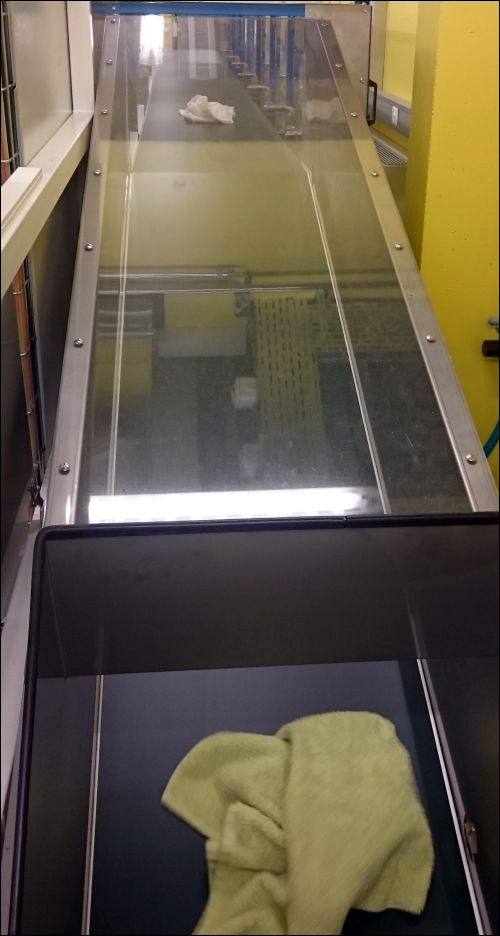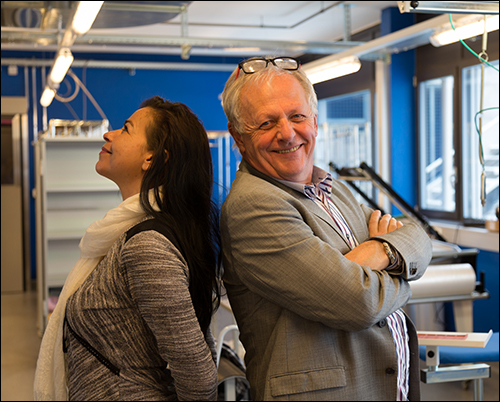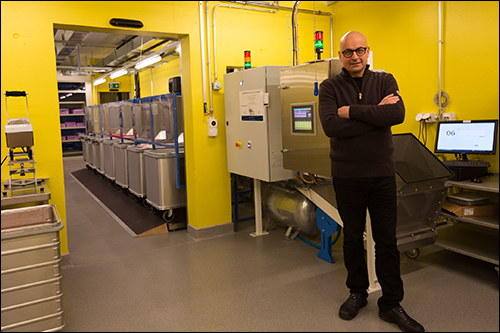Mar 22, 2016Switzerland's Foundation of Valais in Favor of Mentally Handicapped Persons (FOVAHM) has been employing radio frequency identification technology to simplify the process that its mentally handicapped job trainees use to launder linens and clothing belonging to individuals enrolled in FOVAHM's programs.
The FOVAHM foundation provides job-training workshops for people with disabilities. The association houses and trains approximately 360 individuals at its center in Valais. The training includes 17 different professions, one involving work within laundry departments. The facility, known as the mARTigny boutique-hôtel, has a built-in laboratory for training, which serves as its own laundry facility. The La Romaine laundry facility, located in a 360-square-meter (3,875-square-foot) basement, was created both to launder the clothing of all residents and linens used for bedding and dining, and to provide training for about 10 residents who clean those items.

The laundry is separated into two zones. The dirty zone is dedicated to the sorting and washing of soiled linens, while the clean zone is used for the processing of the clean clothes and linens before they are loaded onto trucks destined for the housing areas. Both zones are separated by a tight partition.
To provide a straightforward, error-proof training environment, the association opted to use EPC Gen 2 passive RFID tags and readers. By using the technology, the facility can ensure that the linens are properly sorted, laundered and returned for re-use by the residents.
The RFID system, provided by HygieClean Ltd., consists of HID Global LinTag RFID tags, either heat-sealed or sewn to linens, towels and other laundry, as well as readers installed at the laundry facility, and HygieClean's RFID software to manage data regarding tag reads, store information and display alerts. The software displays information and alerts on computers installed onsite. Small items, such as socks and underpants, are not tagged, but instead receive a 2D thermo-bonded patch.
The deployment includes two RFID tagging stations, where LinTags are affixed to the linens, which include napkins, bed sheets, towels and clothing worn by the residents. The system also comes with two RFID reading stations: one at the conveyor belt at the sorting area within the dirty zone, the other where clean linens and clothes are collected and folded. (HygieClean declined to name the make and model of RFID readers and antennas used to interrogate the tags.) HygieClean software, residing on FOVAHM's server, manages the collected read data.
When first setting up the system, FOVAHM's employees attached a LinTag to each garment or linen item using the label's thermo-adhesive side. They then read the unique ID number encoded to that tag and keyed in a description of that item, including the laundry type, owner's name, color, and laundry handling and delivery instructions.
After that, every time laundry is delivered to the La Romaine laundry facility, it is placed on a conveyor belt within the dirty zone. The two readers installed at this location capture the tag ID numbers and forward that data to the HygieClean software, thereby prompting the system to activate an air jet that moves that item to the appropriate trolley so it can be put through the proper wash cycle.
If a trainee or laundry employee notices a problem, such as a hem that requires repair, he or she can input that data into a computer located onsite. That information will then be stored in the software, along with the item's tag ID number.
When a trolley for a specific load is full, the computer screen flashes an alert. A trainee rolls the trolley to the washer and loads the machine.
Once the items have been cleaned and dried, trainees in the clean zone fold the linen and clothing and transfer them to a reorganization station. At that station—which features a UHF RFID antenna and reader, as well as a 2D bar-code scanner connected to a computer—a trainee confirms which items are being returned to the residential area.
The software counts how many times each tagged item has been washed, by collecting each read event. As trainees stack the folded, cleaned items onto trolleys, the reader again captures the tag IDs and forwards that data to the software, which determines whether the laundry is being directed to the delivery truck.
The software not only ensures that the items move through the laundering and shipping process properly, but also displays alerts on a computer screen onsite. For instance, if a trainee in the dirty zone had noticed repair was necessary, that information would be displayed on the computer screen in the clean zone as the system reads that item's tag. Because the software counts how many times each item is laundered, the system can also display when a specific item has reached its maximum use and should be replaced.
Since installing the technology in 2015, FOVAHM has reported that errors (such as an item being laundered incorrectly—at the wrong temperature, for instance) have been prevented. The system motivates workers and trainees to undertake and learn the work at hand, the foundation notes, since the system is easy to use.
HygieClean was founded in Switzerland in November 2008 by Katia Golay, the company's operating manager, and Hervé Bargibant, its CEO. "From the beginning of the creation of the company," Golay says, "we looked for solutions and products allowing [us] to improve hygiene, working conditions and the productivity of laundries."
"Today, the laundry is processing over 450 kilograms of linen each day," Bargibant states. "The laundry has been designed from the outset to provide 1.2 tons per day."
The company began working with FOVAHM to develop the system in 2012, he says.
The next step for FOVAHM will be to install readers at some of the residences that FOVAHM operates, in order to track dirty linens and clothing as they are removed from those residences, and the clean items as they are returned, says Daniel Zufferey, the association's workshop technical manager. "We are planning to add two or more identification stations for clothes in some of our 22 external workshops. Clothes will then be identified with HID tags before being sent to the laundry."



